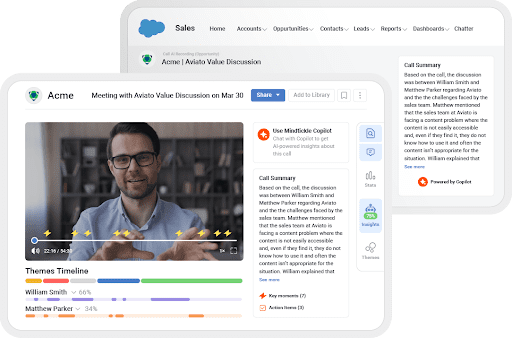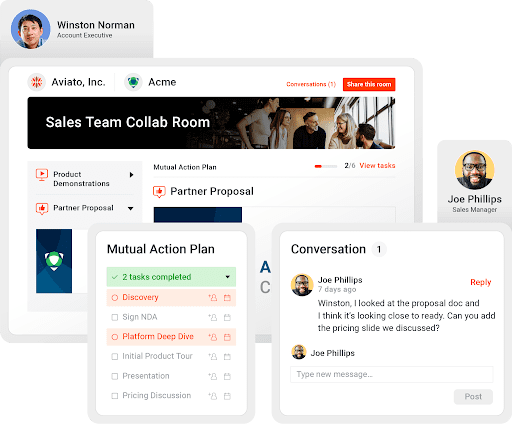The Ultimate Sales Hack: Mindtickle’s Call AI Turbocharges Your Team’s Productivity
![]() Rahul Mathew
on
May 16, 2024
Rahul Mathew
on
May 16, 2024
Meeting revenue targets isn’t just a goal—it’s a priority that comes “BAE” (Before Anything Else).
At Mindtickle, our mission revolves around assisting our customers in overcoming obstacles that obstruct the productivity of their sales teams.
Central to this mission is our product offering: Call AI, a conversation intelligence tool enablement and sales teams leverage to access customer conversations in one central repository while enabling them to analyze seller interactions and track deal progression effortlessly.
As we launch new features, we build solutions that address daily challenges that enablement teams and sales managers experience to enhance enablement and sales team experiences and improve overall productivity.
Let’s look at how Mindtickle’s latest set of features are simplifying the lives of enablement and sales teams.
Evaluating Call AI adoption
Enablement admins use several tools and platforms daily. While managing these tools and platforms is a top priority, understanding how they are used regularly and their adoption is critical to ensuring maximum utilization.
The challenge is that several existing solutions in the market do not provide these insights, leaving admins unable to gauge the effectiveness of their tool adoption strategies.
Our latest release addresses these challenges for our Call AI admins by providing frequent and timely insights into adoption trends. Whether analyzing calls reviewed by sales managers, feedback shared with sellers, or sharing calls internally or externally by sellers. We provide a holistic view of adoption metrics. These insights empower enablement admins to assess user behaviors and refine their Call AI adoption strategies.
Real-time access to Call AI data on the new data platform
Enablement admins need access to raw data beyond the standard reports available in Call AI analytics. However, there is no way to extract this data in real time we are addressing this challenge by providing real-time access to this data via Snowflake (NDP). Another challenge we saw while working with our customers was the inability to continuously develop dedicated integrations with each dialer in the market today.
In our upcoming release, we address this challenge by introducing a seamless SFTP-based integration solution that bridges the gap between Call AI and dialer systems.
Customers can now integrate Call AI with any dialer in the market, improving customer engagement, agent performance, and overall business outcomes. The solution ensures:
- A seamless integration with dialers via a secure SFTP-based mechanism.
- The highest level of data security, compliance, and encryption.
- Insights and analytics derived from conversations.
- Compatibility with a wide array of dialer systems facilitated through a secure SFTP mechanism.
- User-friendly interface for easy adoption and utilization.
Empowering sales managers to select other stakeholders to coach sellers
Sales managers managing big teams are often inundated with so many other responsibilities that providing personalized coaching to sellers on calls is hard. Additionally, not having the ability to assign an expert or external training prevents sellers from being coached for specific calls could delay the effectiveness of sellers in the field.
In this release, we are addressing this challenge by enabling sales managers to assign a coach to reps whether it be:
- Their reporting manager
- An assigned mentor or peer to coach the seller
- An external trainer or a group of trainers (coaching is outsourced) who can coach a rep on calls
This makes sales managers more efficient and ensures sellers receive the right guidance without unnecessary roadblocks.
Giving time back to sellers
Sales managers can find reviewing each seller call tedious. With a conversation intelligence tool, sellers can have all the sales calls in a centralized location. Mindtickle’s Call AI provides a Copilot interface to ask important questions and get appropriate insights.
However, this is not scalable if a sales manager has to listen to many calls.


We addressed this challenge by helping sellers stay on top of their calls. After each call, Call AI automatically generates a call summary that captures key highlights, attendees, and any action items for follow-up.
This summary is easily accessible for sales managers within the Call AI details page, via email, or available directly in the call record in Salesforce. The call summary ensures you have all the crucial information of the deal at your fingertips, saving time and keeping everyone aligned.
To learn more about how we continue to innovate and empower enablement and sales teams worldwide to improve productivity and achieve unprecedented revenue growth and success, register for the upcoming webinar, Sales Superheroes Unleashed: Transforming Sellers into Superstars with AI, on June 5, 2024.
Mindtickle's 2024 Spring Announcement webinar
Learn how forward-thinking teams can change sales behaviors at scale. Speakers from Cisco and International (formerly Navistar) will discuss how they use AI and other capabilities to positively impact their businesses.
Save Your Spot




